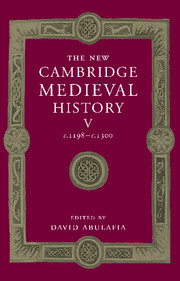Book contents
- Frontmatter
- Introduction
- Part I Common Themes
- Part II The Church in the Thirteenth Century
- Part III The Western Kingdoms
- Part IV Italy
- Part V The Mediterranean Frontiers
- 17 Byzantium after the Fourth Crusade
- 18 The crusades
- 19 Islam and the Mediterranean
- (a) The rise of the Mamluks
- (b) The Maghrib
- (c) The Nasrid kingdom of Granada
- 20 The rise of Aragon-Catalonia
- 21 Castile, Portugal and Navarre
- Part VI The Northern and Eastern Frontiers
- Appendix Genealogical tables
- Primary sources and secondary works arranged by chapter
- Index
- Plate section
- Map 1 Europe in the thirteenth century
- Map 3 France, c. 1260
- Map 5 Germany and the western empire
- Map 6 Genoa, Venice and the Mediterranean
- Map 8 The Latin empire of Constantinople and its neighbours
- Map 10 Aragon and Anjouin the Mediterranean">
- References
(c) - The Nasrid kingdom of Granada
from 19 - Islam and the Mediterranean
Published online by Cambridge University Press: 28 March 2008
- Frontmatter
- Introduction
- Part I Common Themes
- Part II The Church in the Thirteenth Century
- Part III The Western Kingdoms
- Part IV Italy
- Part V The Mediterranean Frontiers
- 17 Byzantium after the Fourth Crusade
- 18 The crusades
- 19 Islam and the Mediterranean
- (a) The rise of the Mamluks
- (b) The Maghrib
- (c) The Nasrid kingdom of Granada
- 20 The rise of Aragon-Catalonia
- 21 Castile, Portugal and Navarre
- Part VI The Northern and Eastern Frontiers
- Appendix Genealogical tables
- Primary sources and secondary works arranged by chapter
- Index
- Plate section
- Map 1 Europe in the thirteenth century
- Map 3 France, c. 1260
- Map 5 Germany and the western empire
- Map 6 Genoa, Venice and the Mediterranean
- Map 8 The Latin empire of Constantinople and its neighbours
- Map 10 Aragon and Anjouin the Mediterranean">
- References
Summary
NO account of Islam in the west, nor indeed of the history of thirteenth-century Europe, would be complete that did not take into account the origins of the one Islamic state in Spain to survive throughout the fourteenth and nearly all the fifteenth century, the Nasrid kingdom of Granada. In the late thirteenth and early fourteenth centuries, prior to the coming of the Turks, it was, indeed, the only Islamic political entity of any size in Europe. In the early thirteenth century the increasingly apparent weakness of the once formidable Almohad empire resulted in a process of fission familiar from earlier centuries of Islamic history in Spain; but the new generation of taifa or party kingdoms that emerged in the early thirteenth century was even more prone to interference by ever more confident Christian kings than had been the case in the earlier taifa periods, during the eleventh and mid-twelfth centuries. The battle of Las Navas de Tolosa in 1212 ensured an end to Almohad dreams of further expansion in Spain; more than that, it revealed fundamental weaknesses in the management of the Almohad army by a less than careful caliph, an-Nasir, and an increasing dependence on hired soldiers. Following his defeat, an-Nasir retired to live at Marrakesh, and (though reports vary) he is said to have died after being bitten by a mad dog or after being hacked to death by black slaves; in any case, the point the Arabic writers wanted to make was that he met the ignominious end he deserved. This was not the spirit of the conquering armies that had overwhelmed North Africa and al-Andalus in the twelfth century.
The reluctance of the Almohad rulers to insist on the full force of Almohad doctrine was apparent by about 1230; indeed, their uncompromising rejection of anything that had the slightest suspicion of anthropomorphism had not won as many supporters in Spain as the movement’s founders may have expected. Andalusi Muslims tended to see the Almohads as outsiders, an impression reinforced by the widespread hostility in Spain to newly arrived Berbers.
- Type
- Chapter
- Information
- The New Cambridge Medieval History , pp. 636 - 643Publisher: Cambridge University PressPrint publication year: 1999

